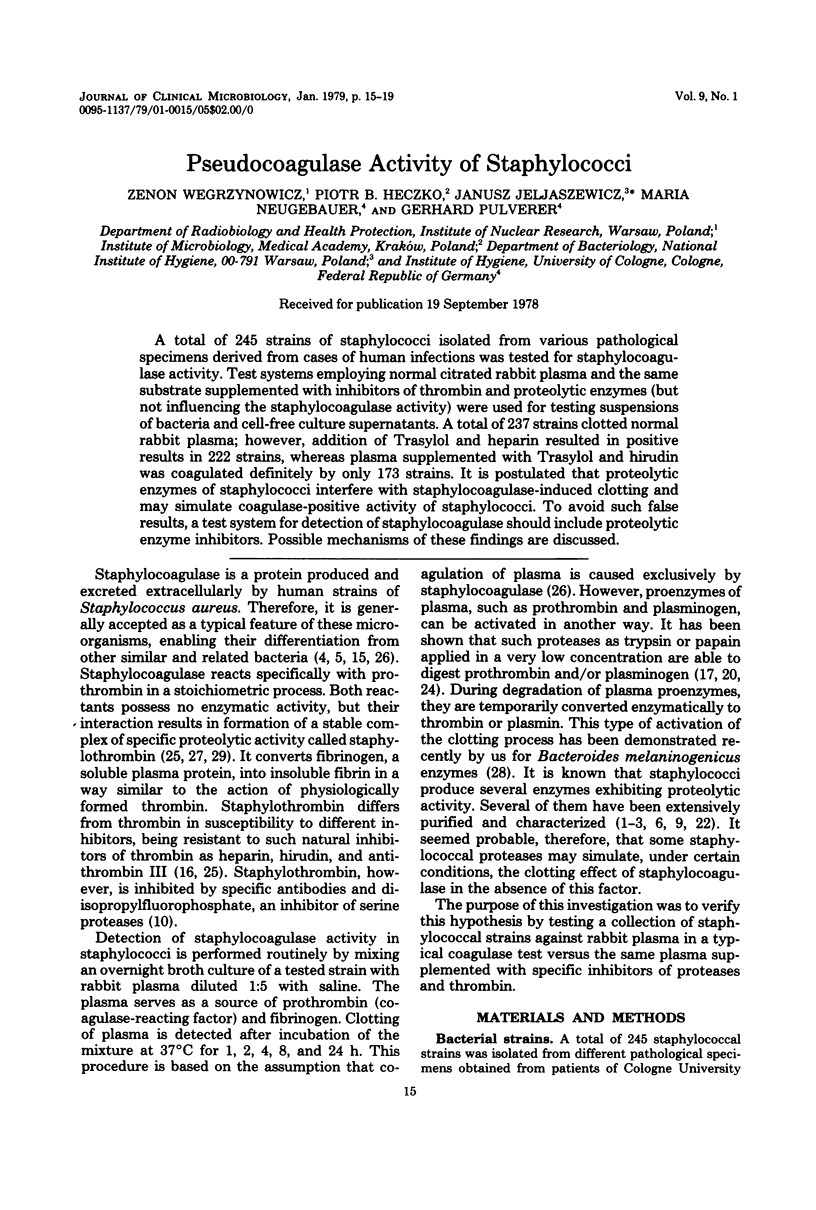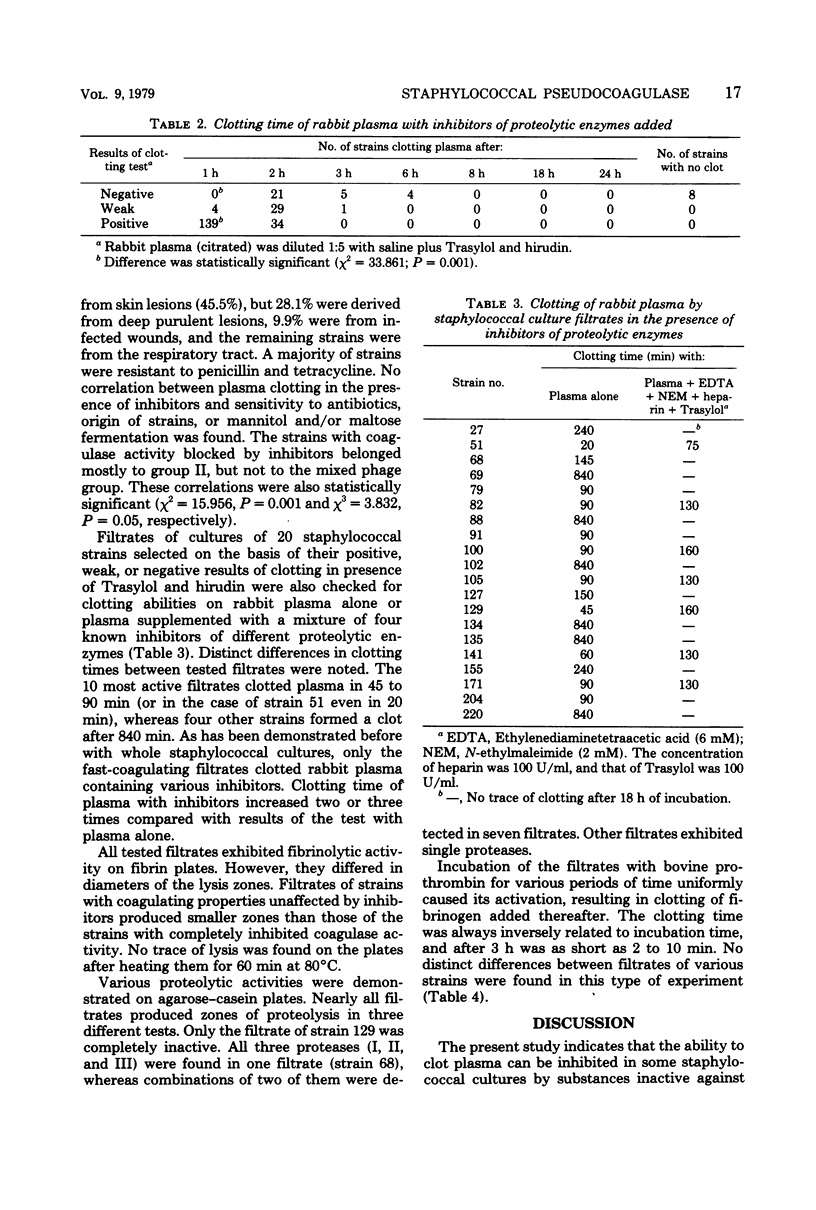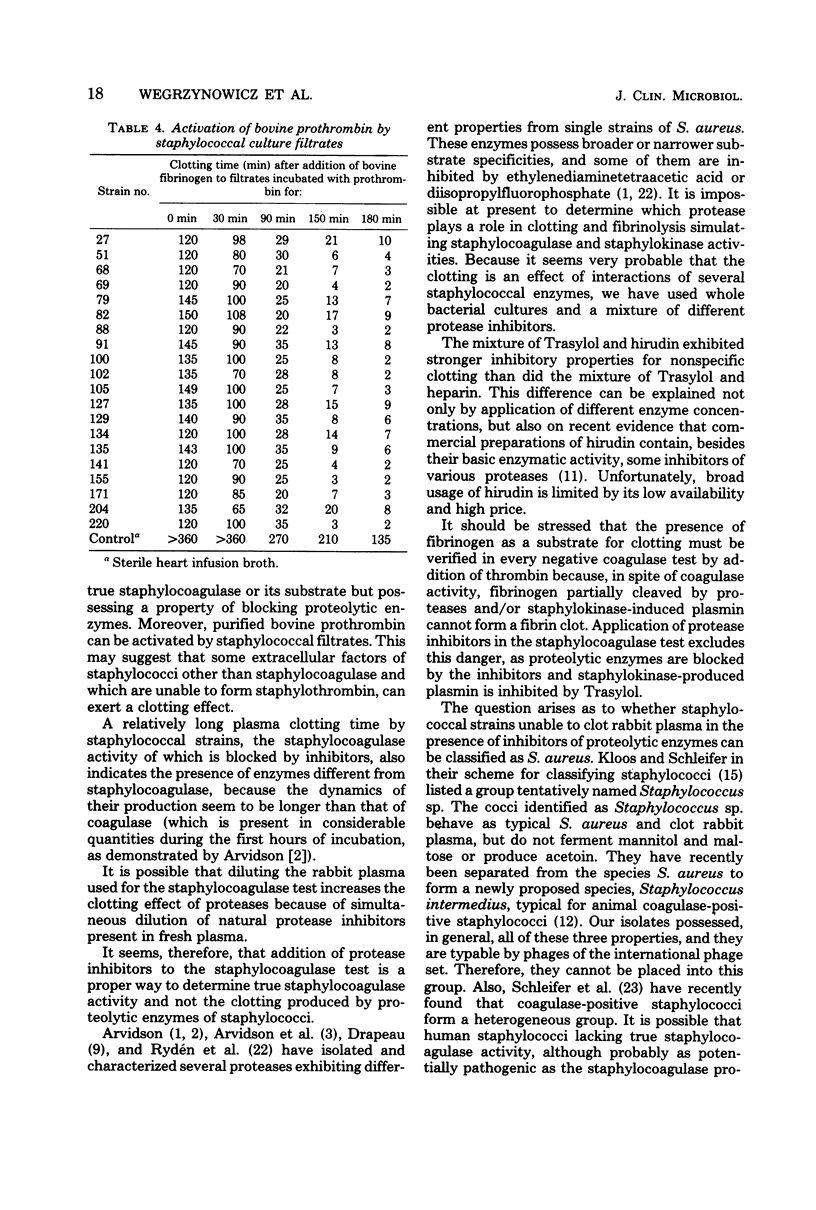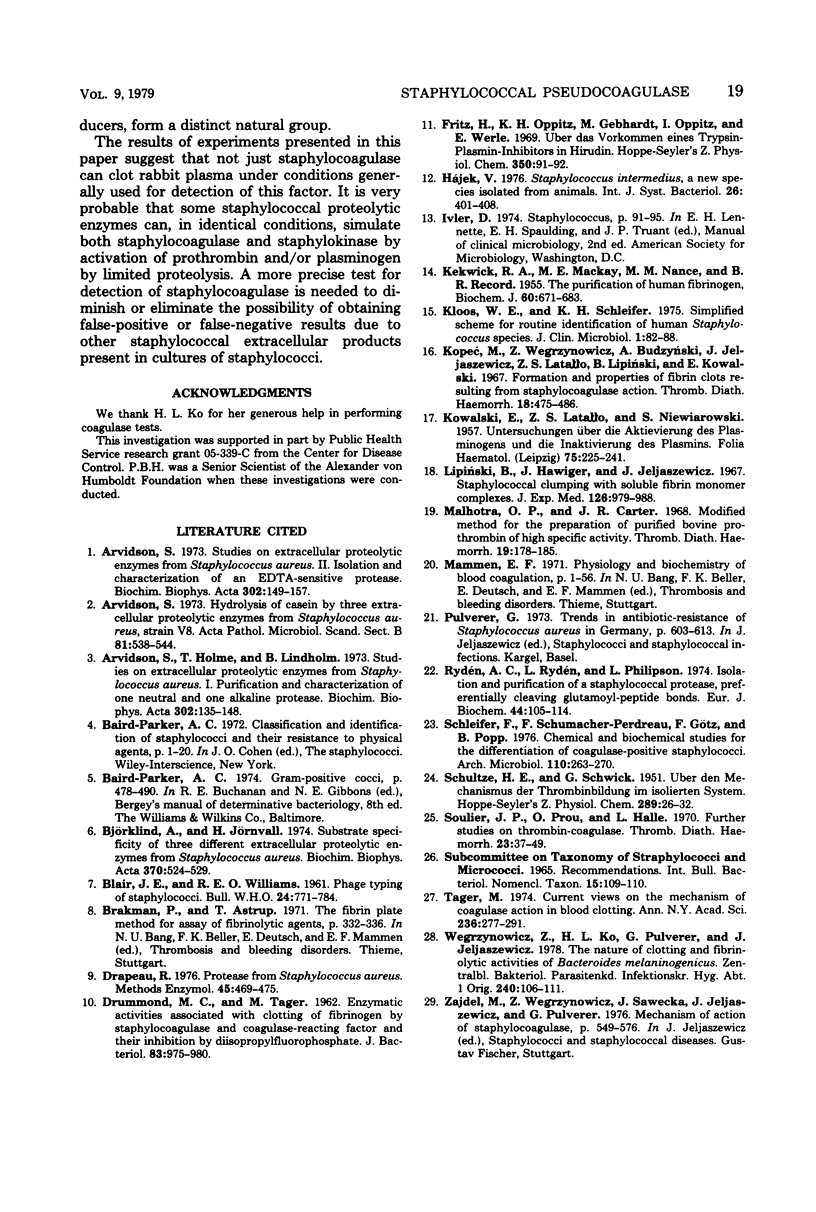Abstract
A total of 245 strains of staphylococci isolated from various pathological specimens derived from cases of human infections was tested for staphylocoagulase activity. Test systems employing normal citrated rabbit plasma and the same substrate supplemented with inhibitors of thrombin and proteolytic enzymes (but not influencing the staphylocoagulase activity) were used for testing suspensions of bacteria and cell-free culture supernatants. A total of 237 strains clotted normal rabbit plasma; however, addition of Trasylol and heparin resulted in positive results in 222 strains, whereas plasma supplemented with Trasylol and hirudin was coagulated definitely by only 173 strains. It is postulated that proteolytic enzymes of staphylococci interfere with staphylocoagulase-induced clotting and may simulate coagulase-positive activity of staphylococci. To avoid such false results, a test system for detection of staphylocoagulase should include proteolytic enzyme inhibitors. Possible mechanisms of these findings are discussed.
Full text
PDF




Selected References
These references are in PubMed. This may not be the complete list of references from this article.
- Arvidson S., Holme T., Lindholm B. Studies on extracellular proteolytic enzymes from Staphylococcus aureus. I. Purification and characterization of one neutral and one alkaline protease. Biochim Biophys Acta. 1973 Mar 15;302(1):135–148. doi: 10.1016/0005-2744(73)90016-8. [DOI] [PubMed] [Google Scholar]
- Arvidson S. Hydrolysis of casein by three extracellular proteolytic enzymes from Staphylococcus aureus, strain V8. Acta Pathol Microbiol Scand B Microbiol Immunol. 1973 Oct;81(5):538–544. doi: 10.1111/j.1699-0463.1973.tb02239.x. [DOI] [PubMed] [Google Scholar]
- Arvidson S. Studies on extracellular proteolytic enzymes from Staphylococcus aureus. II. Isolation and characterization of an EDTA-sensitive protease. Biochim Biophys Acta. 1973 Mar 15;302(1):149–157. doi: 10.1016/0005-2744(73)90017-x. [DOI] [PubMed] [Google Scholar]
- Bjoörklind A., Jörnvall H. Substrate specificity of three different extracellular proteolytic enzymes from Staphylococcus aureus. Biochim Biophys Acta. 1974 Dec 29;370(2):524–529. doi: 10.1016/0005-2744(74)90113-2. [DOI] [PubMed] [Google Scholar]
- DRUMMOND M. C., TAGER M. Enzymatic activities associated with clotting of fibrinogen by staphylocoagulase and coagulase-reacting factor and their inhibition by disopropylfluophosphate. J Bacteriol. 1962 May;83:975–980. doi: 10.1128/jb.83.5.975-980.1962. [DOI] [PMC free article] [PubMed] [Google Scholar]
- Drapeau G. R. Protease from Staphyloccus aureus. Methods Enzymol. 1976;45:469–475. doi: 10.1016/s0076-6879(76)45041-3. [DOI] [PubMed] [Google Scholar]
- Fritz H., Oppitz K. H., Gebhardt M., Oppitz I., Werle E., Marx R. Uber das Vorkommen eines Trypsin-Plasmin-Inhibitors in Hirudin. Hoppe Seylers Z Physiol Chem. 1969 Jan;350(1):91–92. [PubMed] [Google Scholar]
- KEKWICK R. A., MACKAY M. E., NANCE M. H., RECORD B. R. The purification of human fibrinogen. Biochem J. 1955 Aug;60(4):671–683. doi: 10.1042/bj0600671b. [DOI] [PMC free article] [PubMed] [Google Scholar]
- KOWALSKI E., LATALLO Z., NIEWIAROSKI S. Untersuchungen über die Aktivierung des Plasminogens und die Inaktivierung des Plasmins. Folia Haematol Int Mag Klin Morphol Blutforsch. 1957;75(2):225–241. [PubMed] [Google Scholar]
- Kloos W. E., Schleifer K. H. Simplified scheme for routine identification of human Staphylococcus species. J Clin Microbiol. 1975 Jan;1(1):82–88. doi: 10.1128/jcm.1.1.82-88.1975. [DOI] [PMC free article] [PubMed] [Google Scholar]
- Kopeć M., Wegrzynowicz Z., Budzyński A. Z., Jeljaszewicz J., Latallo Z. S., Lipiński B., Kowalski E. Formation and properties of fibrin clots resulting from staphylocoagulase (SC) action. Thromb Diath Haemorrh. 1967 Dec 31;18(3-4):475–486. [PubMed] [Google Scholar]
- Lipiński B., Hawiger J., Jeljaszewicz J. Staphylococcal clumping with soluble fibrin mmonomer complexes. J Exp Med. 1967 Nov 1;126(5):979–988. doi: 10.1084/jem.126.5.979. [DOI] [PMC free article] [PubMed] [Google Scholar]
- Malhotra O. P., Carter J. R. Modified method for the preparation of purified bovine prothrombin of high specific activity. Thromb Diath Haemorrh. 1968 Mar 31;19(1):178–185. [PubMed] [Google Scholar]
- Pulverer G. Trends of antibiotic-resistance of Staphylococcus aureus in Germany. Contrib Microbiol Immunol. 1973;1:603–613. [PubMed] [Google Scholar]
- Rydén A. C., Rydén L., Philipson L. Isolation and properties of a staphylococcal protease, preferentially cleaving glutamoyl-peptide bonds. Eur J Biochem. 1974 May 2;44(1):105–114. doi: 10.1111/j.1432-1033.1974.tb03462.x. [DOI] [PubMed] [Google Scholar]
- SCHULTZE H. E., SCHWICK G. Uber den Mechanismus der Thrombinbildung im isolierten System. Hoppe Seylers Z Physiol Chem. 1951;289(1):26–43. [PubMed] [Google Scholar]
- Schleifer K. H., Schumacher-Perdreau F., Götz F., Popp B. Chemical and biochemical studies for the differentiation of coagulase-positive staphylococci. Arch Microbiol. 1976 Nov 2;110(23):263–270. doi: 10.1007/BF00690237. [DOI] [PubMed] [Google Scholar]
- Soulier J. P., Prou O., Hallé L. Further studies on thrombin-coagulase. Thromb Diath Haemorrh. 1970 Feb 28;23(1):37–49. [PubMed] [Google Scholar]
- Tager M. Current views on the mechanisms of coagulase action in blood clotting. Ann N Y Acad Sci. 1974 Jul 31;236(0):277–291. doi: 10.1111/j.1749-6632.1974.tb41498.x. [DOI] [PubMed] [Google Scholar]
- Wegrzynowicz Z., Ko H. J., Pulverer G., Jeljaszewicz J. The nature of clotting and fibrinolytic activities of Bacteroids melaninogenicus. Zentralbl Bakteriol Orig A. 1978 Jan;240(1):106–111. [PubMed] [Google Scholar]


